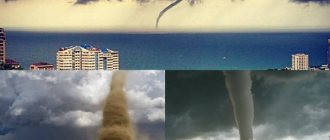Actions in case of a chemical accident
Chemically hazardous objects. accidents at chemically hazardous facilities
Every person must understand what to do during and after an accident at a chemical facility. If it is indoors, the procedure is as follows:
- Close windows, doors, ventilation or smoke openings. Seal the gaps in the joints of the frames with adhesive plaster or other material. Hang blankets and bedspreads on windows and doors.
- Protect the respiratory tract with a mask, respirator or regular gauze (fabric) bandage soaked in an aqueous solution. In case of accidents with the release of chlorine, the bandage is soaked in a 2-5% solution of baking soda, ammonia - 2% solution of citric or acetic acid.
- Do not turn on electrical appliances, turn off heat sources, turn off the gas.
If necessary, leave the premises, take documents and the minimum necessary things, put on clothing that covers the body (rubber boots, raincoat, hat).
Procedure if an emergency occurs while a person is outdoors:
- cover the body with any clothing, a blanket, use respiratory protection;
- find shelter, but avoid basements and lowlands where toxic substances can accumulate;
- leave the contaminated area (the wind should blow from the side or in the face), move as quickly as possible, but do not raise dust.
We recommend reading: Upcycling of clothes, shoes, interior, decor
If there is no personal protective equipment, you need to hold your breath and take short, not deep breaths. After leaving the affected area, remove outer clothing, wash, blow your nose, and rinse your mouth. In case of poisoning, drink plenty of fluids and call a doctor.
Lesson 10Types of accidents at chemically hazardous facilities
From the history of chemical accidents
From the history of chemical accidents
The Indian city of Bhopal became known to the whole world in December 1982. Bhopal gained sad, even tragic fame after an accident at an American chemical plant, which killed more than 3,000 people. It was then that the whole world learned about the city with a population of 800 thousand in the center of India.
While on duty on the night of December 2-3, the operator of the gas tank monitoring unit looked at the instruments with the usual caution. Who knows what to expect from this hectic economy! It was not in vain that some experts argued that the gas tank shut-off valves installed by the Americans did not meet safety requirements. But the instrument needles wavered at the “norm” mark even when a whitish veil shrouded the factory buildings. The operator does not remember anything further. He was taken to the hospital in an unconscious state.
The liquefied substance burst out with force from the underground tanks, immediately turning into a volatile gas. It was methyl isocyanite, a highly toxic gas that served as an intermediate product in the manufacture of pesticides, chemicals used to control agricultural pests and weeds. About 30 tons of methyl isocyanite filled the air basin of the city with toxic fumes.
An alarming factory whistle woke up a workers' village located nearby, and people rushed to the factory, thinking that a fire had broken out. Many of them were fatally poisoned here.
Meanwhile, a gentle wind at a speed of 5 km/h carried the vapors escaping from the gas tanks in a southeast direction. Since the night was cool, they did not rise up, but spread along the ground. A deadly cloud 6 m thick covered urban areas of 40 km2 like morning fog.
The air smelled sweetly of hay, eyewitnesses recalled, and there was poor visibility. They felt dizzy, their eyes hurt, and many felt sick. Exhausted people fell right in the streets.”
At the railway station, located 2 km from the chemical plant, all the employees who were on duty that fateful night and the people waiting for the train died.
Thousands and thousands of city residents, inhaling the poison, ran away from their homes. They suffered from acute burning eyes, uncontrollable coughing, and bouts of vomiting. Many townspeople never woke up: death overtook them in bed.
Indian authorities took urgent and vigorous measures to eliminate the consequences of the disaster and provide assistance to those affected. Army units were immediately deployed to Bhopal to ensure order and security and search for poisoned and dead people in houses and on the streets in the vicinity of the city. Special teams of doctors and environmental protection specialists arrived and began delivering medicines and oxygen cylinders to the city to save those caught in the toxic fog. They hastily began converting schools into hospitals and building tent cities to house people fleeing the contaminated area.
Of particular interest was the operation to neutralize 15 tons of methyl isocyanite remaining in the storage facility of a chemical plant. It was held in mid-December for five days. Emergency measures were taken to completely eliminate the possibility of its leakage into the atmosphere. A water screen was created above and around the plant: three planes and five helicopters continuously sprayed water over the contaminated area.
Shops, educational institutions, businesses and institutions were closed in the city. The population from the nearest neighborhoods was evacuated to specially created tent cities.
In total, as a result of this disaster, up to 200 thousand people were affected - almost a quarter of the population of Bhopal. In addition, it caused incalculable damage to the surrounding nature. Fields and roads were strewn with dead animals and birds. Even the giant buffaloes could not survive. The toxic gas completely destroyed crops within a 100-mile (167 km) radius. For a long time, the affected land remained barren.
Next page Dangerous chemical
Occurrence and development of accidents at chemically hazardous facilities
A chemical accident is a chemical accident at a hazardous facility, which is accompanied by the release of hazardous chemical substances (HCS) or spillage and can with a high probability lead to infection or mass death of people, agricultural plants and animals, or to global or local contamination of the natural environment
That is why special attention is paid to the industrial safety of chemical facilities
Release of chemical substances
- this is the release of chemical substances during depressurization in a relatively short period of time from containers for transportation or storage, technological installations in quantities that can lead to a chemical accident.
Spillage of chemical substances
is a leakage during depressurization from containers for transportation or storage, technological installations in an amount that can cause a chemical accident.
A chemical contamination zone (CZZ)
is an area that has been contaminated with hazardous chemicals in a vapor, aerosol, gaseous, or droplet-liquid state.
A hotbed of emergency exposure to chemically hazardous substances (HAS)
is an area where, as a result of exposure to hazardous substances, massive damage to people, plants and farm animals occurred. Consequently, the lesion is formed in the inner part of the zone of chemical contamination with hazardous substances, while it has boundaries that are not identical from the last. The size of the hazardous waste directly depends on the number of hazardous substances at the facility at the time of the disaster and inversely depends on the value of the toxodose (mg*min/l), their toxic and physicochemical properties, the nature of the area and weather conditions. ZHZ hazardous chemicals are characterized by the width and depth of spread of the contaminated cloud.
Sources of chemical hazards in case of accidents at hazardous production facilities
- volley releases of hazardous chemicals into the atmosphere with subsequent contamination of water sources, terrain, and air;
- “chemical” type of fire with the release of hazardous substances and various combustion products into the environment;
- discharge of hazardous substances into water bodies;
- explosions of hazardous chemicals, as well as raw materials necessary for their production or initial products;
- the formation of zones with a high level of smoke and the subsequent deposition of hazardous chemicals in the form of “spots” along the trail left after the spread of a cloud of contaminated air, migration and sublimation.
Each of the sources of danger (damage) indicated above in time and place, which can appear sequentially, separately or in combination with other sources, or repeated many times in various combinations. This depends on the conditions of the accident, the physical and chemical characteristics of hazardous substances, weather conditions and terrain features. Thus, if chemical accidents occur at hazardous production facilities with the release of hazardous chemicals, the source of chemical damage will have its own characteristics. They must be taken into account when conducting a rescue operation by a professional emergency rescue unit (PARF) and a non-standard emergency rescue unit.
— Formation of clouds of toxic vapor. Their distribution in the environment is a very complex process, which is determined by the phase state diagrams of hazardous chemicals, as well as the main physical and chemical characteristics, weather conditions, storage conditions, terrain, etc., therefore it is very difficult to predict the scale of chemical contamination (pollution). — As a rule, in the midst of an accident, there are several damaging factors at the site - chemical contamination of the area, water bodies, air; low or high temperature, shock wave, and chemical contamination of the environment occurs outside the object. — The most dangerous damaging factor is exposure to toxic chemical vapors through the respiratory system. This factor operates both at large distances from the release source, spreading at the speed of wind transfer of hazardous substances, and at the accident site. — Concentrations of hazardous substances that are dangerous to life can exist in the atmosphere for several hours or several days, in turn, contamination of the area and water can persist for an even longer time. — The lethal outcome depends on the toxic dose, the properties of hazardous substances, and can occur either after some time (or even several days) or instantly, immediately after poisoning.
https://youtube.com/watch?v=MBa3wJgyQiE









